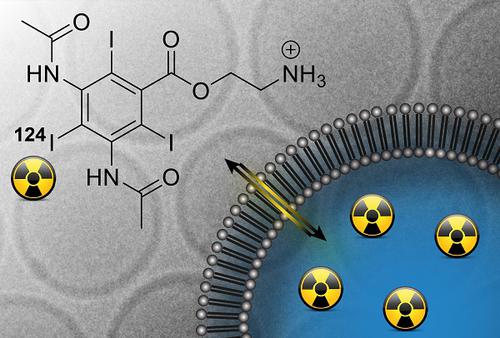Theranostics ( IF 12.4 ) Pub Date : 2018-11-12 , DOI: 10.7150/thno.26706 Gokce Engudar , Henrik Schaarup-Jensen , Frederikke P. Fliedner , Anders E. Hansen , Paul Kempen , Rasmus I. Jølck , Andreas Kjæer , Thomas L. Andresen , Mads H. Clausen , Andreas I. Jensen , Jonas R. Henriksen

|
Long circulating liposomes entrapping iodinated and radioiodinated compounds offer a highly versatile theranostic platform. Here we report a new methodology for efficient and high-yield loading of such compounds into liposomes, enabling CT/SPECT/PET imaging and 131I-radiotherapy.
Methods: The CT contrast agent diatrizoate was synthetically functionalized with a primary amine, which enabled its remote loading into PEGylated liposomes by either an ammonium sulfate- or a citrate-based pH transmembrane gradient. Further, the amino-diatrizoate was radiolabeled with either 124I (t1/2 = 4.18 days) for PET or 125I (t1/2 = 59.5 days) for SPECT, through an aromatic Finkelstein reaction.
Results: Quantitative loading efficiencies (>99%) were achieved at optimized conditions. The 124I-labeled compound was remote-loaded into liposomes, with an overall radiolabeling efficiency of 77 ± 1%, and imaged in vivo in a CT26 murine colon cancer tumor model by PET/CT. A prolonged blood circulation half-life of 19.5 h was observed for the radiolabeled liposomes, whereas injections of the free compound were rapidly cleared. Lower accumulation was observed in the spleen, liver, kidney and tumor than what is usually seen for long-circulating liposomes.
Conclusion: The lower accumulation was interpreted as release of the tracer from the liposomes within these organs after accumulation. These results may guide the design of systems for controlled release of remote loadable drugs from liposomes.
Keywords: remote loading, pH-gradient liposomes, transmembrane ammonium sulfate, iodinated imaging agents, I-124, PET imaging
中文翻译:

用124 I-放射性碘标记的化合物远程加载脂质体,并通过PET / CT在鼠肿瘤模型中进行体内评估
捕获碘化和放射性碘化化合物的长循环脂质体提供了高度通用的治疗学平台。在这里,我们报告了一种新的方法,可将此类化合物高效且高产率地负载到脂质体中,从而实现CT / SPECT / PET成像和131 I放射疗法。
方法:利用伯胺对功能增强的CT造影剂重氮酸盐进行了合成功能化,从而可以通过基于硫酸铵或柠檬酸盐的pH跨膜梯度将其远程装载到PEG化脂质体中。此外,通过泛芳芬克斯坦反应对氨基二重氮酸盐进行了PET的124 I(t 1/2 = 4.18天)或SPECT的125 I(t 1/2 = 59.5天)放射性标记。
结果:在优化条件下实现了定量加载效率(> 99%)。将124 I标记的化合物远程装载到脂质体中,总放射标记效率为77±1%,并通过PET / CT在CT26鼠结肠癌肿瘤模型中进行体内成像。对于放射性标记的脂质体,观察到延长的血液循环半衰期为19.5小时,而注射的游离化合物则迅速清除。与长循环脂质体相比,在脾脏,肝脏,肾脏和肿瘤中观察到的蓄积量较低。
结论:较低的积累被解释为积累后示踪剂从这些器官中的脂质体释放。这些结果可能指导系统控制脂质体中远程可装载药物的释放。
关键词:远程装载,pH梯度脂质体,跨膜硫酸铵,碘化显像剂,I-124,PET显像


















































 京公网安备 11010802027423号
京公网安备 11010802027423号